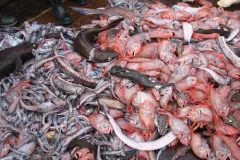Rough Going for Orange Roughy

In the dark, cold waters 600 meters (nearly 2000 feet) below the ocean's surface, things happen slowly. Orange roughy (Hoplostethus atlanticus), deep ocean fish that were once known as "slimeheads" because of the mucous-producing canals on their heads, grow and mature at a sluggish rate compared to most shallow water fish. They don't reproduce until they are at least 20 years old and can reportedly live to be 149.
Before 1980, orange roughy lived their long, plodding lives mostly beyond human reach. But in the past few decades, as fish in shallow waters near the coast have become harder to find, many fishermen have expanded into deeper waters – including the orange roughy's habitat.
In a short time, the fish's popularity as a food item exploded. Roughy often gather in large groups, so fisherman could easily haul in big batches using trawl nets—wide-mouthed nets that are dragged behind boats. These sudden, large harvests did not leave the roughy enough time to reproduce and stocks began declining quickly, especially near New Zealand, Australia and Namibia. In some places roughy fishing has been restricted, but scientists expect the slow-growing fish's recovery to take many years.
Heavy orange roughy fishing has taken its toll in other ways, too. The wide mouth of a trawl net often pulls in other unwanted animals, called bycatch, which are usually thrown back into the ocean dead or dying. Areas of the seafloor and seamounts (underwater mountains) where roughy hang out have also been scraped and scarred by trawl nets. Seamounts, which host a wide diversity of corals, fish, and other animals, can take decades to heal. While most deep-sea fish are slow growing and vulnerable to overfishing, not all are in danger. For example, the sablefish (Anoplopoma fimbria), found in deep waters of the northeast Pacific, is a well-studied and successfully managed commercial fishery. To find out which fish are okay to eat and which need a break from our dinner plates, download a sustainable seafood guide.


